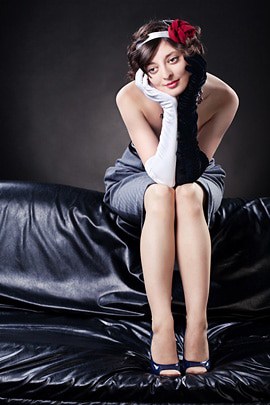Today at PhotoBuyerGuide.com we present interview with Anatoly Tiplyashin, who is one of the successful microstock photographers. We suppose that this conversation will be interesting for either buyers or photographers.
– Lets begin with the very start. How did you get involved in microstock industry and why did you choose it as your main occupation?
– It had happened accidentally. I studied at the university in 2005 and our teacher at photography told us about internet stock agencies, where everyone can sell images. So I decided to find out more about it. After reading several forums I became one of the stock photographers. And now it's my main occupation. Why? It's very simple: it provides me enough money for living, traveling, purchasing required photo stuff. And of course when working with microstocks I can get rid of direct relations with clients and their just requirements — I really don't like that.
– At what microstocks buyer can find your images?
– I have almost every image of my portfolio at Shutterstock, Fotolia and Dreamstime. Also I contribute to iStockphoto and Depositphotos. My early pictures are available at Bigstock and 123RF. Several images can be purchased at Getty Images. Well, that's it.
– Can you mark some microstock out of this list you're working with?
– For me the most important things are: profitability and usability of the stock agency. By these clauses I can mark out Shutterstock, Fotolia and Dreamstime. iStockphoto is also profitable, but I feel uncomfortably using its upload system and requirement of model release of its own form.
– Can you describe typical buyer of your images?
– I guess I can't, cause too many people and various companies use microstocks for their needs. And sometimes they use purchased images in a very unexpected manner. For example, my photograph of mother and child which is obviously suitable for some child care magazine was published in a computer magazine.

– Usually I shoot Christmas and New Year subjects. The other holidays and events are not so close to me. I think that if you want to make photographs about foreign events you will have to know their history, traditions and customs very well. Or it'll be more useful to participate in one of such events. And I don't have direct connection to microstock buyers. Just sometimes I'm asked to sell some image exclusively. It means that I have to remove it everywhere after the sale.
– What photographs do you like to take most of all if we talk about traditional stock subjects?
– Girls! Young and beautiful. To be more specific — I shoot everything that is of current importance. To be honest I'm slightly sick of traditional subjects especially of those that's called “isolated”. So right now I photograph what I like. And it sells!
– How do you get ideas and subjects for future shooting? And how do you prepare for it?
– The ideas that sell are very well known — just look at TOPs of stock agencies. To be successful is to introduce some original touches to the traditional subjects. It's very hard and I can say that it happens unpurposely. Anyway usually I look through various magazines and sites, make some conclusions for myself and then go shooting.
– What do you take with you for shooting?
– My camera and model. To be serious: it depends of the shooting. In studio you have everything you need. To shoot outdoors I take flashes, radio-synchronizers, stands and umbrellas.
– One of the main parts of great photo is the model. How do you choose them? Is there any requirements?
– The main requirement for me is the age of majority. Then I make a choice looking through model's images made desirably by unprofessional photographers. I look at the hair, smile, eyes… If the girl makes the same expression on her face at every image — she doesn't suit me. Also I take into consideration how model communicates. If she is polite and at the same time has a good sense of humor — it's good. Well, I can continue, but in short that's all.
– How much images from the whole shooting you select to sell at microstocks?
– Sometimes it's 90 percent, sometimes — only 20. It depends on many factors. Did I and model get well ready for shooting? Or was the model emotional enough? Sometimes they are so very shy and shooting outcome tends to nothing.
– How much time do you spend post-processing images?
– Well, if it's on white background then maximum of 10 minutes per photograph. If it's some complicated subjects or outdoor shooting then it could take hours to finish the post-processing.
– Many stock photographers use their own opinion of the appearance of the image for best sales. For example, cropping, colors, etc. What about you?
– If the image is lifeful, if it has good emotions, dynamics and mood then it doesn't need any post-processing at all. Though it'll be useful. Technically photograph must be bright, vivid, sharp, and noiseless.
– As a photographer what microstock do you think to be the best choice for buyers?
– I guess every microstock has almost the same image gallery. But I can mark out iStockphoto for it has great collection of exclusive images.
– Is it interesting for you the way of usage of your images? And how often do buyers tell you about it?
– Of course, it's interesting! But buyers don't tell me much about it. So I have to find the products with my images by myself. Or sometimes my friends tell me.
– What about choosing your best images by your opinion?
– Of course it's my photo of my wife and daughter, I playing the role of miner, retro images made with great master of style — Svetlana Prihnenko, some sea series images… I guess, I have many favorites.
– We know that there were several incidents concerning using your images with violation of the copyright. Tell about it in short.
– There is not much to tell about. Both cases ended for me successfully. I was paid reasonable compensation. The first time designer took my photo from the internet and used it for a big advertising poster. The next time one of the big companies used my photo for advertising purposes under the wrong license.
– What is more suitable for you: Royalty Free or Rights Managed?
– Royalty Free is preferable. More money, less troubles.
– What do you think about the future of microstock industry?
– I think that images will always be in need. Maybe it will transform into something else cause of developing of technologies. But necessity of visualization of advertisements, articles, sites, books and other will remain.
Links to Anatoly Tiplyashin portfolio
Tiplyashin.com | Shutterstock | iStockphoto | Fotolia | Dreamstime | 123RF | Bigstock | Depositphotos
Photo Credits
“close-up portrait worker man” by AnatolyTiplyashin at iStockphoto.com.
“mother with new born baby” by Tiplyashin Anatoly at Shutterstock.com.
“WOMAN IN RETRO STYLE” by Krasphoto at Dreamstime.com.








